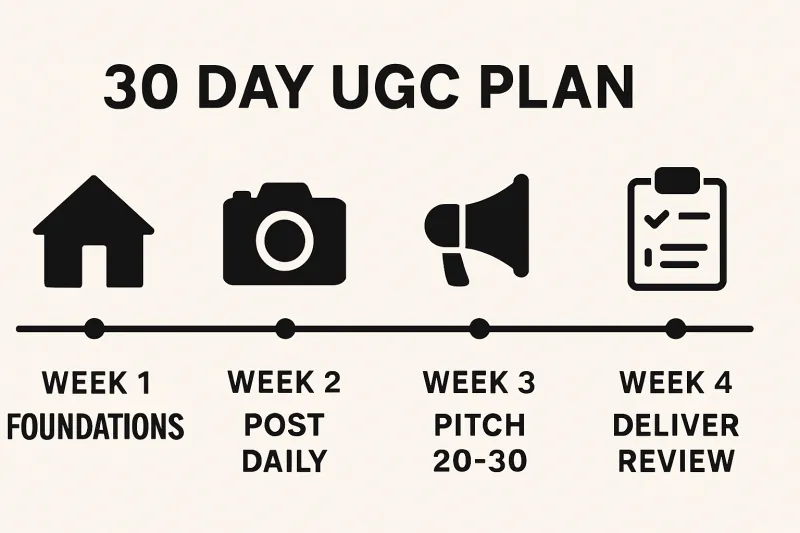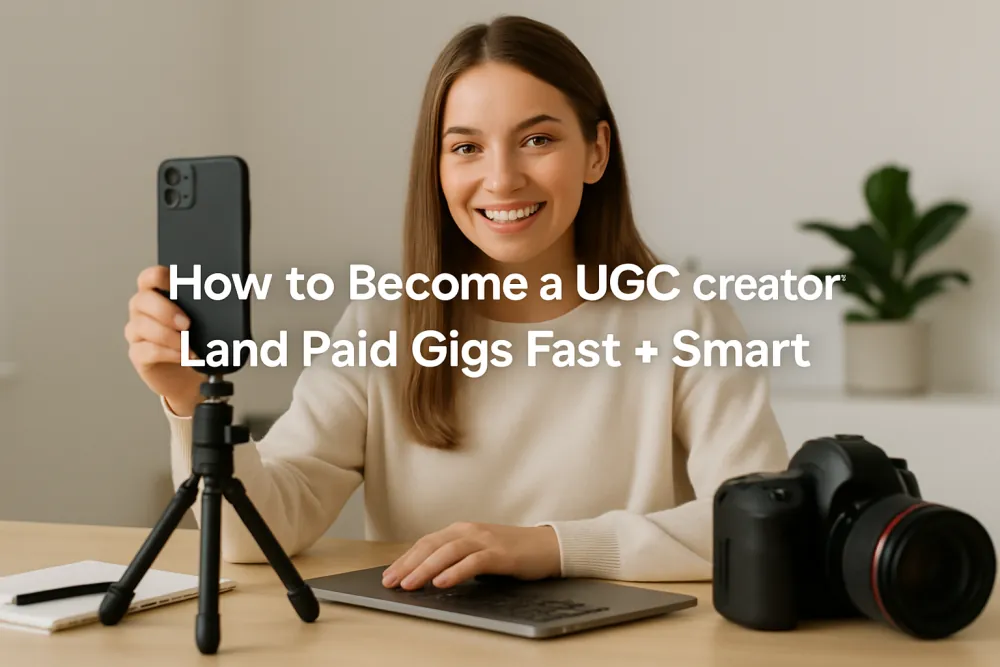You don't need a huge following to get paid to create. In 2026, brands want real, high-converting content they can use in ads and on social. This guide shows you exactly how to become a UGC creator, build a portfolio in 24 hours, pitch with confidence, and land paid gigs fast.
We'll cover the difference between UGC creators and influencers, current rates and demand, gear and scripting, a 30-day plan, platforms to pitch, pricing basics, and the workflow that keeps you consistent while you focus on paid work.
UGC Creator vs. Influencer: What Brands Want in 2026
What is a UGC creator? A UGC creator makes content that looks like it came from a real customer—think testimonials, demos, and unboxings—but gets paid by brands to make it. It's valued because it looks real and converts in ads and on social. Research shows UGC influences buying: large majorities say UGC impacts purchase decisions and is more trusted than polished brand content (Iconosquare) and (Later).
Brands buy UGC even if you have no audience. They're buying content and usage rights to use across their own channels. As Hootsuite notes, paid UGC can be just as real as organic UGC—only the creator gets paid (Hootsuite).
What a UGC Creator Actually Does
Typical deliverables include:
- Short-form videos (9–30s hooks, 30–60s demos/tutorials)
- Testimonials and POV reviews
- Unboxings and before/after sequences
- Product photos, reels, carousels, and copy snippets
Where brands use them: paid ads (Meta/TikTok), organic posts, Stories/Reels/TikToks, YouTube Shorts, landing pages, email, and product detail pages. Many advertisers prioritise UGC in their ad creative because it earns attention and clicks—UGC-based ads have been reported to significantly outperform traditional ads in CTR and trust metrics (SocialPilot).
Influencer vs. UGC Creator: Key Differences
Here's how UGC creators and influencers differ:
- Audience: UGC creators don't need an audience; brands use content on their channels. Influencers need their own audience to make money.
- Pricing: UGC creators charge per-asset, package, or retainer; licensing drives price. Influencers charge based on audience size, engagement, and deliverables.
- Usage rights: UGC creators sell licensing (duration, platforms), whitelisting, exclusivity. Influencers have limited brand use unless negotiated.
- Performance: UGC creators focus on conversion-focused creative that fits briefs. Influencers focus on brand awareness and creator-led reach.
- Face on camera: UGC creators can stay off-camera; product-first. Influencers usually need to show their face; personal brand-first.

Which Path Fits You? Quick Self-Check
- You enjoy scripting, filming, and editing more than building a public persona.
- You're happy to let brands run your content as ads (with proper licensing).
- You want faster income ramp-up without waiting to grow followers.
- You're detail-oriented and like working from brand briefs.
If most of these sound like you, UGC creation is likely a better fit than traditional influencing.
The UGC Opportunity in 2026: Rates, Niches, and Demand
UGC demand in the U.S. remains strong because it delivers social proof. Multiple industry surveys report shoppers consider UGC highly influential during purchase decisions (Iconosquare) and (Later).
Typical UGC Creator Salary & Pay Models
How creators get paid:
- Per-asset: Flat fee per video/photo; pricing increases with usage/length.
- Packages: Bundles (e.g., 3–5 videos + cuts) at a better unit rate.
- Retainers: Monthly content quotas for ongoing brands.
Factors that move price: usage duration (30/90/365 days), platforms (paid ads vs organic), whitelisting (brand runs ads from your handle), and exclusivity (you avoid competitors for a period). Real-world example: creator Lauren Gates started in 2023 and charged up to $125 per video early on—rates grow with speed, quality, and results (Buffer).
High-Demand Niches Right Now
- Beauty and skincare: Demos, before/after, routine videos.
- CPG and beverages: Unboxings, flavour taste tests, lifestyle shots.
- Fitness/wellness: POV workouts, gear demos, supplement reviews.
- Home & DIY: Hacks, organisation, quick transformations.
- SaaS: Screen demos, "how it works," testimonial shorts.
- Local services: Treatments, tours, staff highlights, FAQs.
Brands like Poppi and Aerie frequently feature community content to build trust and loyalty—evidence that relatable, real-life visuals resonate and are reused across channels (Later) and (SocialPilot).
Starter Packages Brands Say Yes To
- Test Drive (48–72h): 2 short vertical videos (15–30s), 1 photo set (5 shots), 1 hook variant. Light editing. 30-day organic use.
- Launch Bundle (7 days): 4 videos (mix of demo/testimonial/tutorial), 2 cutdowns, 10 photos. 90-day paid + organic usage; add-on for whitelisting.
- Always-On (monthly): 6–8 videos + 10 photos, 2 hooks per video, 2 revisions, monthly learning report. Optional exclusivity in niche.
Skills & Starter Kit: What You Need (and Don't)
You can ship paid-quality UGC with minimal gear. Focus on clear audio, bright lighting, and tight scripts—then iterate from feedback.
Minimum Viable Gear
- Smartphone with 4K/1080p and stabilisation.
- Lighting: Window light or a small softbox; bounce with a white foam board.
- Audio: Wired lav mic (plug-and-play is fine).
- Support: Tripod, small desktop stand, or phone clamp.
- Editing (free): CapCut, VN, or DaVinci Resolve; remove filler words and keep pacing tight.
Formats Brands Buy Over and Over
- Hook–Demo–Proof–CTA: 3s hook, 10–20s demo, proof (results/testimonial), clear CTA.
- Before/After: Problem snapshot → process → reveal.
- POV Review: First-person experience; over-the-shoulder shots.
- Step-by-Step Tutorial: 3–5 steps with on-screen beats.
- Testimonial: Specific outcome, timeframe, and who it's for.
Confidence on Camera and Scripting Fast
One-minute script template:
- Hook (0–3s): Call out the problem or outcome.
- Context (3–8s): Who you are + why you care.
- Demo (8–35s): Show the product solving the problem.
- Proof (35–50s): Specific result, timeframe, or testimonial.
- CTA (50–60s): Tell viewers exactly what to do next.
Delivery tips: Stand near light, keep the mic close, glance at bullet prompts (not full paragraphs), and smile on the CTA.
How to Start UGC in 30 Days: A Weekly Plan
Follow this roadmap from zero to first paid gig. Consistency > perfection.
Week 1: Build Foundations and Your First 5 Assets
- Pick a niche: beauty, CPG, fitness, home, SaaS, or local.
- Craft 2–3 offers: Test Drive, Launch Bundle, retainer.
- Create 5 spec assets: 3 short videos + 2 photo sets for dream brands.
- Portfolio link: Simple Notion/Drive or a one-page landing page.
Week 2: Post Daily and Seed Social Proof
- Post 1 short per day on TikTok/Instagram; alternate formats.
- Repurpose: cut 1 video into 2–3 variants (hook swaps, captions).
- Share BTS and script snippets to show your process.
To stay consistent without burnout, schedule posts in a visual calendar and recycle evergreen proof. Many creators grow faster by recycling their best clips; see how content recycling multiplied engagement in this case study.
Week 3: Apply and Pitch 20–30 Targets
- Send tailored pitches to 20–30 brands (DTC, SaaS, local).
- Use job boards and marketplaces (see below).
- Track responses and schedule follow-ups at 3 and 7 days.
Week 4: Close, Deliver, and Collect Testimonials
- Confirm scope, usage, timeline, and payment terms in writing.
- Deliver on time. Offer one round of edits aligned to the brief.
- Request a 1–2 sentence testimonial and permission to share results.
- Line up a second client using your fresh proof.

Build a Portfolio That Sells in 24 Hours
Your portfolio only needs to do three things: show outcomes, match a brand's tone, and make it easy to contact you.
Create 3 Spec Pieces for Dream Brands
- Pick three brands in one niche and mirror their tone and angles.
- Use high-intent hooks (problem/outcome) and clear CTAs.
- Write short captions highlighting the customer outcome (e.g., "Saved 10 minutes every morning").
Produce Fast with AI: Storyteller & SlidePiece
Short on time? Draft scripts and turn them into rapid videos with Storyteller, and turn testimonials or tips into carousels/threads with SlidePiece. These AI tools help you ship more, faster—without feeling robotic—so you can pitch sooner and book gigs.
Host and Share: Link-in-Bio, Drive/Notion, Landing Page
- Centralise assets in a clean link (Notion/Drive or simple site).
- Include 1–2 best videos up top, proof points, and a "Work with me" button.
- Schedule teasers from your portfolio across platforms to drive inbound.
Platform Playbooks: TikTok and Instagram
These are the two most active discovery channels for UGC. Show your work where brands are already looking.
How to Become a UGC Creator on TikTok
- Profile: Clear headshot or niche icon; bio with niche + offer; contact email.
- Searchable bio: Include "UGC creator" + niche keywords.
- Posting cadence: 1 short daily; alternate hooks and formats.
- Hashtags: Mix broad (#ugccreator) + niche (#saasdemo) + intent (#ugcvideos).
- DM etiquette: When brands engage, reply with thanks, one proof point, and a simple booking link.
How to Become a UGC Creator on Instagram
- Bio & Highlights: Niche, offers, email, and a "Portfolio" highlight.
- Reels strategy: 3 pillars: demos, testimonials, and quick tips.
- Branded content tools: Be ready to tag paid partnerships when needed.
- Inbound: Pin a Reel with your best work + CTA to collaborate.
Want a deeper dive on time-saving scheduling across platforms? See our guide to picking the best social media scheduler for 2026 here.
Where and How to Apply to Be a UGC Creator
You'll win by combining inbound (posting daily) with targeted outbound (applications and cold outreach).
Marketplaces and Boards that Actually Book
- Freelance: Fiverr, Upwork, Contra
- UGC-specific: Trend, Insense, Billo
- Social search: LinkedIn (search "UGC creator" + niche + "hiring") and brand job pages
Cold Email/DM Templates That Get Replies
DTC eCommerce
Subject: Fast UGC ideas for {{Brand}}
Hi {{Name}} — I made two 20s demo hooks for {{Product}} that match your current creative.
I can deliver 3 videos + 5 photos in 7 days with 90-day usage.
1-line proof: Recent UGC for {{Similar Brand}} lifted CTR 28%.
Want me to send a private link?
– {{Your Name}}, UGC CreatorSaaS
Subject: Short product demo UGC for {{Tool}}
Hey {{Name}}, I shot a 30s screen demo that mirrors your landing page value prop.
Offer: 3x 30s demos + 3 cutdowns + 1 customer-style testimonial in 10 days.
Optional: founder voiceover.
Open to a quick preview?
– {{Your Name}}Local business
Subject: Short Reels that book {{Service}}
Hi {{Name}}, I live near {{City}} and can film 3 before/after Reels + 10 photos next week.
Clear offer: 7-day turnaround, 30-day organic use, 1 revision.
Free add-on: 5 FAQ captions.
Worth a chat?
– {{Your Name}}Follow-Up System (Never Lose a Lead)
- Track each pitch date in a simple sheet.
- Schedule follow-ups at +3 days, +7 days, +14 days.
- Use a visual calendar so you never forget nudges.
Pricing, Contracts, and Usage Basics
Keep it simple, protect your time, and price based on usage—not just effort.
Starter Pricing Ladder (From First Gig to Retainers)
- Proof stage: Lower entry pricing for first 1–2 clients to build case studies.
- Package stage: Bundle 3–5 assets; add fees for 90–365 day usage and whitelisting.
- Retainer stage: Monthly quotas, faster turnarounds, and quarterly price reviews.
Usage Rights, Whitelisting, and Add-Ons
- Usage rights: License duration, geos, and platforms. Renewals cost extra.
- Whitelisting: Brand runs paid ads from your handle—charge a monthly fee.
- Exclusivity: You avoid direct competitors in the niche for X months—price accordingly.
For disclosure and endorsements, review the FTC's guidance on endorsements and testimonials here.
Negotiation Scripts You Can Steal
Scope guard: "Happy to add that extra cut. That would be an additional $X or we can swap it with [deliverable] in the current scope."
Usage clarity: "This quote includes 90-day paid + organic usage across Meta and TikTok. Extensions beyond 90 days are $X per month."
Payment terms: "I begin upon 50% deposit, with the remainder due on delivery. If that works, I'll send the invoice and brief today."
Workflow to Scale: Automate with Wahlu
Consistency wins deals. Wahlu keeps your social active while you focus on paid work. It's an affordable social media scheduler with a visual calendar, automated queues to recycle evergreen content, and AI creators—Storyteller for video and SlidePiece for carousels/threads.
Set Up Cross-Platform Posting in Minutes
- Connect Instagram, TikTok, YouTube, LinkedIn, and Facebook.
- Plan your content on a visual calendar so posts land when your audience is active.
- Batch-schedule one week in under an hour—then get back to client work.
Never Go Dark: Recycle Evergreen Proof with Queues
Load testimonials, portfolio snippets, and best-performing posts into content queues to auto-recycle them. Recycling multiplies reach and saves production time; we've documented massive engagement lifts from smart recycling strategies—see how we 60x'd follower engagement using recycling here.
Queues can also replace complex automations. See the InfoTik case study where a queue simplified a Make.com setup here.
Create More, Faster: Storyteller and SlidePiece
- Storyteller: Turn scripts into short videos to pitch or post.
- SlidePiece: Convert tips/results into carousels and threads in minutes.
Save Money Without Sacrificing Reach
Wahlu is budget-friendly—up to 94% cheaper than competitors—so you can scale posts across platforms without draining your margins. When you're ready to move fast and stay consistent, it's time to Start your free trial.
Metrics That Matter (and Simple Reporting)
Track what proves your content works. Share short weekly learnings to win repeat work.
Performance Signals to Track
- Thumb-stop rate: % of viewers who pause in the first 3 seconds.
- Watch time / retention: Do viewers finish the key message?
- CTR: Click-through from post/ad to site.
- CPA proxies: For top-of-funnel UGC, track cost per engaged view or add-to-cart.
- Comment sentiment: Screenshots of questions/praise act as social proof.
Lightweight Weekly Report Template
- Wins: Best-performing hook(s) and what to repeat.
- Learnings: One thing to change in the next batch.
- Links: Folder to raw assets + exported deliverables.
- Next steps: What you'll ship next week and when.
Common Mistakes That Stall New UGC Creators
Scope Creep, Slow Turnarounds, Over-Editing
- Set boundaries: Agree on deliverables, usage, timeline, and revision count upfront.
- Deliver on time: Under-promise, over-deliver. Use a calendar and checklists.
- Edit to the brief: Cut ruthlessly. Keep videos short and on-message.
Inconsistent Posting and Weak Hooks
- Cadence: One post daily on TikTok/Instagram builds momentum fast.
- Hooks: Start with a pain or outcome; test 2–3 hook variants per concept.
Your Next 3 Moves (Do These Today)
1) Build a 3-Piece Portfolio
- Create 3 spec assets for one niche and publish them.
- Keep outcomes front and centre (what changed for the customer).
2) Apply to 10 Live Gigs with a Short Pitch
- Use the templates above; send 10 targeted pitches today.
- Schedule follow-ups at +3, +7, +14 days.
3) Start Posting with Wahlu
- Connect accounts, load your queue, and schedule 7 days of posts.
- Use Storyteller and SlidePiece to keep daily momentum. Start your free trial.
When you're ready to scale with less stress, Start your free trial and let automation handle the consistency while you focus on client work.
FAQ
How do I become a UGC creator with no experience?
Pick a niche, create 3 spec videos, build a one-page portfolio, and pitch 10 brands. Post daily on TikTok/Instagram to attract inbound leads.
Pick a niche, create 3 spec videos, build a one-page portfolio, and pitch 10 brands. Post daily on TikTok/Instagram to attract inbound leads.
Do I need a big following to get paid?
No. UGC creators sell content and licensing to brands; audience size isn't required.
No. UGC creators sell content and licensing to brands; audience size isn't required.
How much do UGC creators make per video?
It varies by usage, complexity, and experience. Newer creators may start lower; rates rise with results and licensing terms.
It varies by usage, complexity, and experience. Newer creators may start lower; rates rise with results and licensing terms.
What's the difference between a UGC creator and an influencer?
UGC creators sell content to brands for their channels; influencers monetise their own audience and personal brand.
UGC creators sell content to brands for their channels; influencers monetise their own audience and personal brand.
Do I need to show my face?
Not always. Many UGC assets are product-first with voiceover or hands-only shots.
Not always. Many UGC assets are product-first with voiceover or hands-only shots.




